
Richard Norman Shaw
Encyclopedia
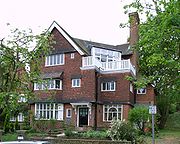
Edinburgh
Edinburgh is the capital city of Scotland, the second largest city in Scotland, and the eighth most populous in the United Kingdom. The City of Edinburgh Council governs one of Scotland's 32 local government council areas. The council area includes urban Edinburgh and a rural area...
, Scotland
Scotland
Scotland is a country that is part of the United Kingdom. Occupying the northern third of the island of Great Britain, it shares a border with England to the south and is bounded by the North Sea to the east, the Atlantic Ocean to the north and west, and the North Channel and Irish Sea to the...
, 7 May 1831 – London, England, 17 November 1912), was an influential Scottish architect from the 1870s to the 1900s, known for his country houses and for commercial buildings.
Life
Shaw trained in the London office of William BurnWilliam Burn
William Burn was a Scottish architect, pioneer of the Scottish Baronial style.He was born in Edinburgh, the son of architect Robert Burn, and educated at the Royal High School. After training with the architect of the British Museum, Sir Robert Smirke, he returned to Edinburgh in 1812...
with George Edmund Street
George Edmund Street
George Edmund Street was an English architect, born at Woodford in Essex.- Life :Street was the third son of Thomas Street, solicitor, by his second wife, Mary Anne Millington. George went to school at Mitcham in about 1830, and later to the Camberwell collegiate school, which he left in 1839...
and attended the Royal Academy classes, receiving a thorough grounding in classicism, and met William Eden Nesfield
William Eden Nesfield
William Eden Nesfield was an English architect, designer and painter.W. E. Nesfield was the eldest son of the landscape architect and painter William Andrews Nesfield. He was educated at Eton and then articled to the architect William Burn in 1850, transferring after two years to his uncle by...
, with whom he was briefly in partnership. In 1854 – 1856 he travelled with a Royal Academy scholarship, collecting sketches that were published as Architectural Sketches from the Continent, 1858.
In 1863, after sixteen years of training, he opened a practice for a short time with Nesfield. In 1872, Shaw was elected an Associate of the Royal Academy
Royal Academy
The Royal Academy of Arts is an art institution based in Burlington House on Piccadilly, London. The Royal Academy of Arts has a unique position in being an independent, privately funded institution led by eminent artists and architects whose purpose is to promote the creation, enjoyment and...
.
He worked, among others, for the artists John Callcott Horsley
John Callcott Horsley
John Callcott Horsley RA , was an English Academic painter of genre and historical scenes, illustrator, and designer of the first Christmas card. He was a member of the artist's colony in Cranbrook.-Life:...
and George Henry Boughton
George Henry Boughton
George Henry Boughton was an Anglo-American landscape and genre painter, illustrator and writer.-Life and work:...
, and the industrialist Lord Armstrong
William George Armstrong, 1st Baron Armstrong
William George Armstrong, 1st Baron Armstrong CB, FRS was an effective Tyneside industrialist who founded the Armstrong Whitworth manufacturing empire.-Early life:...
. He designed large houses such as Cragside
Cragside
Cragside is a country house in the civil parish of Cartington in Northumberland, England. It was the first house in the world to be lit using hydroelectric power...
and Grim's Dyke
Grim's Ditch (Harrow)
Grim's Ditch or Grim's Dyke or Grimes Dike is an area of countryside in the London Borough of Harrow, close to the Hertfordshire borderline. It extends about two miles from Bushey Heath to Harrow and is most easily reached via Stanmore...
, as well as a series of commercial buildings in a wide range of styles.
Shaw was elected to the Royal Academy
Royal Academy
The Royal Academy of Arts is an art institution based in Burlington House on Piccadilly, London. The Royal Academy of Arts has a unique position in being an independent, privately funded institution led by eminent artists and architects whose purpose is to promote the creation, enjoyment and...
in 1877, and co-edited (with Sir Thomas Jackson
Thomas Graham Jackson
Sir Thomas Graham Jackson, 1st Baronet RA was one of the most distinguished English architects of his generation...
RA
Royal Academy
The Royal Academy of Arts is an art institution based in Burlington House on Piccadilly, London. The Royal Academy of Arts has a unique position in being an independent, privately funded institution led by eminent artists and architects whose purpose is to promote the creation, enjoyment and...
) the 1892 collection of essays, Architecture, a profession or an Art?. He firmly believed it was an art. In later years, Shaw moved to a heavier classical style which influenced the emerging Edwardian Classicism
Classicism
Classicism, in the arts, refers generally to a high regard for classical antiquity, as setting standards for taste which the classicists seek to emulate. The art of classicism typically seeks to be formal and restrained: of the Discobolus Sir Kenneth Clark observed, "if we object to his restraint...
of the early 20th century. Shaw died in London, where he had designed residential buildings in areas such as Pont Street
Pont Street
Pont Street is a fashionable street in Knightsbridge and Belgravia, central London, England, not far from the Knightsbridge department store Harrods to the north-west. The street crosses Sloane Street in the middle, with Beauchamp Place to the west and Cadogan Place, and Chesham Place, to the east,...
, and public buildings such as New Scotland Yard.
His picturesque early country houses avoided the current Neo-Gothic and the academic styles, reviving vernacular materials like half timber
Timber framing
Timber framing , or half-timbering, also called in North America "post-and-beam" construction, is the method of creating structures using heavy squared off and carefully fitted and joined timbers with joints secured by large wooden pegs . It is commonplace in large barns...
and hanging tiles, with projecting gable
Gable
A gable is the generally triangular portion of a wall between the edges of a sloping roof. The shape of the gable and how it is detailed depends on the structural system being used and aesthetic concerns. Thus the type of roof enclosing the volume dictates the shape of the gable...
s and tall massive chimney
Chimney
A chimney is a structure for venting hot flue gases or smoke from a boiler, stove, furnace or fireplace to the outside atmosphere. Chimneys are typically vertical, or as near as possible to vertical, to ensure that the gases flow smoothly, drawing air into the combustion in what is known as the...
s with "inglenook
Inglenook
An inglenook , or chimney corner, is a small recess that adjoins a fireplace.Inglenook may also refer to:*Inglenook, California, community in Mendocino County...
s" for warm seating. The result was free and fresh, not slavishly imitating his Jacobean
Jacobean architecture
The Jacobean style is the second phase of Renaissance architecture in England, following the Elizabethan style. It is named after King James I of England, with whose reign it is associated.-Characteristics:...
and vernacular models, yet warmly familiar, a parallel to the Arts and Crafts movement
Arts and Crafts movement
Arts and Crafts was an international design philosophy that originated in England and flourished between 1860 and 1910 , continuing its influence until the 1930s...
. Richard Norman Shaw's houses soon attracted the misnomer the "Queen Anne style
Queen Anne Style architecture
The Queen Anne Style in Britain means either the English Baroque architectural style roughly of the reign of Queen Anne , or a revived form that was popular in the last quarter of the 19th century and the early decades of the 20th century...
". As his powers developed, he dropped some of the mannered detailing, his buildings gained in dignity, and acquired an air of serenity and a quiet homely charm which were less conspicuous in his earlier works; half timber construction was more sparingly used, and finally disappeared entirely.
His work is characterised by ingenious open planning, the Great Hall or "sitting hall" with a staircase running up the side that became familiar in mass-produced housing of the 1890s.
He was also involved in ecclesiastical architecture. He restored St. John's Church, Leeds
St John the Evangelist's Church, Leeds
St John the Evangelist's Church, Leeds, is a redundant Anglican church in the centre of the city of Leeds, West Yorkshire, England. It has been designated by English Heritage as a Grade I listed building, and is under the care of the Churches Conservation Trust...
and designed new churches such as St. Margaret's, Ilkley
Ilkley
Ilkley is a spa town and civil parish in West Yorkshire, in the north of England. Ilkley civil parish includes the adjacent village of Ben Rhydding and is a ward within the metropolitan borough of Bradford. Approximately north of Bradford, the town lies mainly on the south bank of the River Wharfe...
, All Saints', Leek
Leek, Staffordshire
Leek is a market town in the county of Staffordshire, England, on the River Churnet. It is an ancient borough and was granted its royal charter in 1214.It is the administrative centre for the Staffordshire Moorlands District Council...
and All Saints', Richards Castle.
Built work
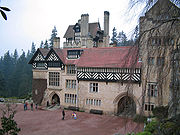
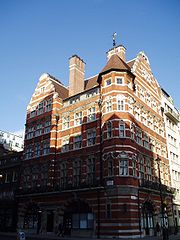
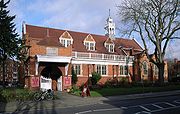
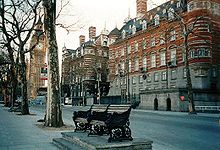
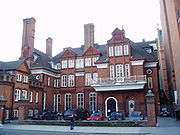

- 1-2 St James St, London, 1882
- Glen Andred, at WithyhamWithyhamWithyham is a village and large civil parish in the Wealden district of East Sussex, England. The village is situated 10 miles south west of Tunbridge Wells and 3.5 miles from Crowborough; the parish covers approximately .-Geography:Withyham parish lies on the edge of Weald, in the...
,Sussex, 1867 - Leyswood, at Withyham,Sussex, 1866–1869
- CragsideCragsideCragside is a country house in the civil parish of Cartington in Northumberland, England. It was the first house in the world to be lit using hydroelectric power...
, at RothburyRothburyRothbury is a town and civil parish in Northumberland, England. It is located on the River Coquet, northwest of Morpeth and north-northwest of Newcastle upon Tyne...
, Northumberland, 1869/1870–1885 - Preen Manor, Shropshire
- Grim's DykeGrim's DykeGrim's Dyke is the name of a house and estate located in Harrow Weald, in Northwest London, England, built in 1872 by Norman Shaw, and named after the nearby pre-historic earthwork known as Grim's Ditch. The house is best known as the home of dramatist W.S. Gilbert, who lived there for the last...
, Harrow, London, 1870 - New Zealand Chambers, Leadenhall StreetLeadenhall StreetLeadenhall Street is a street in the City of London, formerly part of the A11. It runs east from Cornhill to Aldgate, and west vice-versa. Aldgate Pump is at the junction with Aldgate...
, London, c. 1870–80 - Pierrepont and Merrist Wood, Surrey
- Lowther LodgeLowther LodgeLowther Lodge is a house in South Kensington, London, England, immediately south of Hyde Park. It was designed by Richard Norman Shaw and built between approximately 1872 and 1875. It is an important example of Victorian Queen Anne architecture, with gothic influences...
, Kensington, 1873–1875, headquarters of the Royal Geographical SocietyRoyal Geographical SocietyThe Royal Geographical Society is a British learned society founded in 1830 for the advancement of geographical sciences... - 6 Ellerdale Road6 Ellerdale Road6 Ellerdale Road is a house built by the Arts and Crafts movement architect Richard Norman Shaw for himself in the period of 1874 to 1876....
, Hampstead, London, built for himself - House of Bethany, St Clement's Road, Bournemouth, Dorset, 1874–1875
- WispersWispersThis article is about Wispers, the building near Midhurst which has housed several schools. For Wispers School at Wispers, see Wispers School.Wispers is a Grade II listed British country house in the parish of Stedham with Iping near Midhurst, West Sussex...
, West Sussex, 1874–1876 - Pierrepont House, FrenshamPierrepont School, FrenshamPierrepont School, Frensham, originally known as Pierrepont House School, was an independent school in Surrey, England, with day boys as well as boarders. Founded in 1947, it became co-educational in 1983 and closed in 1993.-History:...
, 1876–78 - Old Swan House, 17 Chelsea Embankment, London, 1875–1877
- Bedford ParkBedford Park, LondonBedford Park is a suburban development in west London, England. It forms a conservation area that is mostly within the London Borough of Ealing, with a small part to the east within the London Borough of Hounslow. The nearest underground station is Turnham Green .-History:It can be justly described...
, London, the first "garden city" suburban development: housing, including St Michael and All Angels Church, 1879–1882 - Albert Hall Mansions, at Kensington Gore, London, 1879–1886
- AdcoteAdcoteAdcote School is an independent non-selective day and boarding school for girls, located in the village of Little Ness, five miles northwest of Shrewsbury, Shropshire, England. The school was founded in 1907, and is set in a Grade I listed country house built in 1879 for Rebecca Darby, the widow...
, Little Ness, Shropshire, 1876–1881 - Flete HouseFlete HouseFlete House is a Grade I listed country house at Holbeton, in the South Hams district of Devon, England.Flete was a Saxon estate, the manor being held by the Damarell family from the reign of William I until the time of Edward III....
, Devonshire - Greenham Lodge, Berkshire
- Dawpool, Cheshire (demolished, 1920s)
- Bryanston SchoolBryanston SchoolBryanston School is a co-educational independent school for both day and boarding pupils in Blandford, north Dorset, England, near the village of Bryanston. It was founded in 1928...
, Dorset - Chesters, Northumberland
- New Scotland Yard, on the Thames Embankment, London, 1887–1906 (built as the headquarters of the Metropolitan PoliceMetropolitan Police ServiceThe Metropolitan Police Service is the territorial police force responsible for Greater London, excluding the "square mile" of the City of London which is the responsibility of the City of London Police...
, now known as the Norman Shaw Buildings and used as ParliamentaryParliament of the United KingdomThe Parliament of the United Kingdom of Great Britain and Northern Ireland is the supreme legislative body in the United Kingdom, British Crown dependencies and British overseas territories, located in London...
offices) - Piccadilly Hotel, Piccadilly CircusPiccadilly CircusPiccadilly Circus is a road junction and public space of London's West End in the City of Westminster, built in 1819 to connect Regent Street with the major shopping street of Piccadilly...
, London, England, 1905 to 1908; his last work - Albion HouseAlbion House, LiverpoolAlbion House is a Grade II* listed building located in Liverpool, England. It was constructed between 1896 and 1898 and is positioned on the corner of James Street and the Strand across from the Pier Head.-History:...
, James Street, LiverpoolLiverpoolLiverpool is a city and metropolitan borough of Merseyside, England, along the eastern side of the Mersey Estuary. It was founded as a borough in 1207 and was granted city status in 1880...
, 1896–1898 - House for Kate GreenawayKate GreenawayCatherine Greenaway , known as Kate Greenaway, was an English children's book illustrator and writer, who spent much of her childhood at Rolleston, Nottinghamshire. She studied at what is now the Royal College of Art in London, which at that time had a separate section for women, and was headed by...
, FrognalFrognalFrognal is an affluent area in North West London in the London Borough of Camden between Hampstead and West Hampstead. Frognal is also the name of the major road in the area.-History:...
, London, 1885 - Swanscombe Church in Kent
- White Lodge and White Lodge West, BingleyBingleyBingley is a market town in the metropolitan borough of the City of Bradford, in West Yorkshire, England. It is situated on the River Aire and the Leeds and Liverpool Canal...
, West Yorkshire - Bannow, Residential Care Home, St Leonards-on-SeaSt Leonards-on-SeaSt Leonards-on-Sea is part of Hastings, East Sussex, England, lying immediately to the west of the centre. The original part of the settlement was laid out in the early 19th century as a new town: a place of elegant houses designed for the well-off; it also included a central public garden, a...
, East Sussex, 1877 - Claremont School, originally the Ebden family home named Baldslow Place, St.Leonards-on-Sea, East Sussex 1888
- 4 - 6 Page Heath Lane, Bickley, Kent, 1864
- The Corner House, 114 Shortlands Road, Beckenham, Kent, 1869
- 88 St. James's Street, London, 1904
- Bailiff's Cottage, Bromley Palace Estate, Bromley, Kent, 1864 (demolished)
- Town Hall, Market Square, Bromley, kent, 1863 (unexecuted)
- Bradford City HallBradford City HallBradford City Hall is a Grade I listed, 19th century town hall in Centenary Square, Bradford, West Yorkshire, England, and is notable for its landmark bell/clock tower.- As town hall :The building was designed by Lockwood and Mawson, and opened in 1873....
extension 1909. - Holy Trinity Church, Bingley, Yorkshire 1866-1868 (demolished 1974)
- Holme Grange School, Wokingham, Berkshire East Sussex 1883
- Alderbrook Park, Cranleigh, Surrey 1881 (house for Pandeli RalliPandeli RalliPandeli Ralli JP DL was a British politician.Born in France, son of Toumazis Stephanou Ralli of Ralli Brothers, Pandeli graduated from King's College London with a Bachelor of Arts degree. He was elected Liberal Member of Parliament for Bridport in 1875 and held the seat until 1880...
, demolished 1956) - Flora FountainFlora FountainFlora Fountain, at the Hutatma Chowk , is an ornamentally and exquisitely sculpted architectural heritage monument located at the southern end of the historic Dadabhai Naoroji Road, called the Mile Long Road, at the Fort business district in the heart of South Mumbai, Mumbai, India...
, Mumbai, India, 1864 - Highdown SchoolHighdown SchoolHighdown School and Sixth Form Centre is an academy in Emmer Green on the outskirts of Reading, Berkshire, England. It has a capacity for approximately 1450 students aged 11–18.Highdown School has three Grade II listed buildings within its grounds...
, Emmer Green, Reading, Berkshire, 1878-80
External links
- Great Buildings on-line: Richard Norman Shaw
- Illustrations of Adcote
- Flickr photoset

